Robotics
Soap Bubbles: Understanding Vortex Flow in Soap Bubbles: Implications for Robotics and Heart Health | Bengaluru News

Bengaluru: Blowing soap bubbles is a simple joy that has delighted children and adults alike for generations. But behind this innocent pastime lies a display of fluid dynamics, according to new research from Indian Institute of Science (IISc).A team led by professor Saptarshi Basu has provided the first experimental glimpse into the flow patterns created as air rushes into a soap bubble through a nozzle. Using high-speed videography, they found the inflating air forms a striking vortex shape resembling a doughnut.Initially, the air enters the bubble in a simple jet. But as the soap film curves inward, it causes the airflow to spin into a swirling, doughnut-shaped vortex. The researchers were able to derive mathematical formulas predicting the inflation rate and strength of this inner vortex based on factors such as air pressure and velocity.While seemingly a trivial phenomenon, understanding the vortex flow within bubbles has applications in diverse areas where membranes interact with flowing fluids. From inflating balloons for soft robotics to blood flow within the heart’s chambers, modelling these internal flows could be crucial for optimising designs and controlling dynamics.“Everyone is familiar with soap bubbles, but their intricate behaviour still captivates scientists and the public alike. We’re thrilled this work showcasing the hidden complexities of something so simple and aesthetic has piqued such wide interest,” the researchers said.Pointing out that traditionally, studies on soap bubbles have focused on the behaviour of the liquid film itself — how it moves, its shape, and reactions to various factors — Saini Jatin Rao, first author of the study, published in the journal Physical Review Fluids, told TOI the novelty in their research was they shifted focus to understanding the evolution of air inside the bubble, a phenomenon largely unexplored.“While the initial motivation for the study was sheer curiosity about the inner workings of soap bubbles, the findings have opened up a vast array of potential applications, ranging from robotics and artificial organs to a deeper understanding of the mechanics within natural biological systems,” Rao said.“The study’s findings could have significant implications for the field of soft robotics, where inflatable chambers and balloons are commonly used. By understanding how air flows and redistributes pressure within these structures, researchers may be able to design more efficient and controlled soft robotic systems, including those used for intricate surgical procedures,” Rao explained. He added the team also found parallels between the vortex formations observed inside soap bubbles and those occurring in the chambers of the human heart. “This correlation could potentially lead to new methods for assessing heart health by analysing the strength and patterns of these vortices.”



